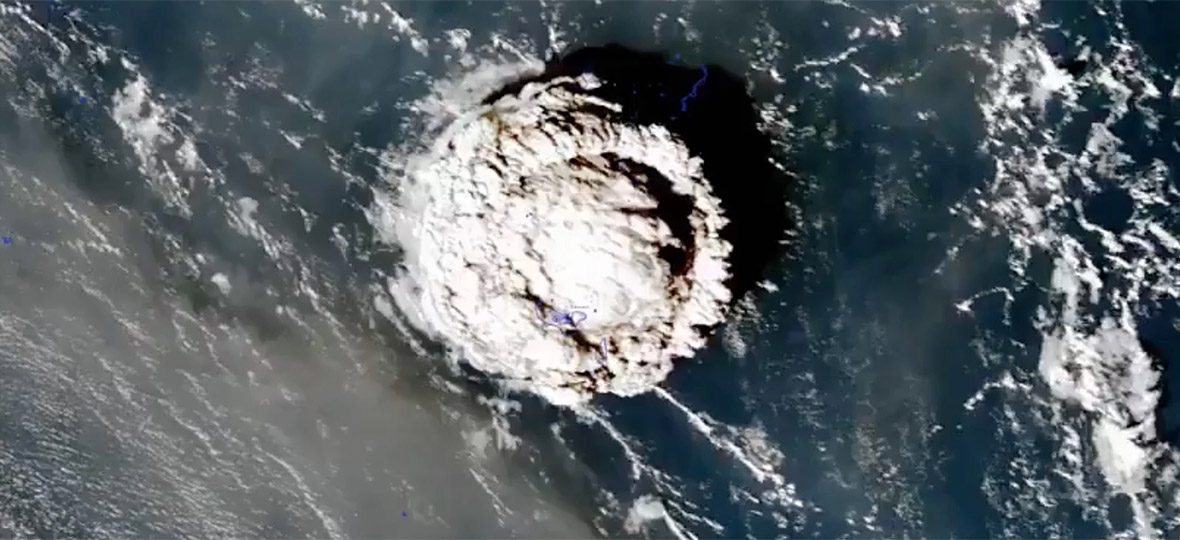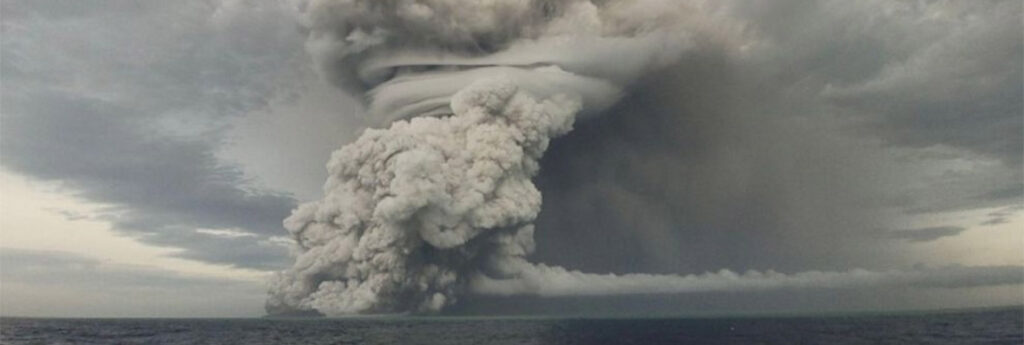New Zealand and Australia were able to send military surveillance flights to Tonga on Monday to assess the damage caused by a huge undersea volcanic eruption on Saturday. A towering ash cloud had prevented earlier flights and communication in the Pacific Island nation is still severely limited.
New Zealand hopes to send essential supplies, including much-needed drinking water, on a military transport plane today (Tuesday).
U.N. humanitarian officials and Tonga’s government “report significant infrastructural damage around Tongatapu,” the main island in the archipelago, U.N. spokesman Stephane Dujarric said.
“There has been no contact from the Ha’apai Group of islands, and we are particularly concerned about two small low-lying islands – Mango and Fonoi – following surveillance flights confirming substantial property damage,” Dujarric said.
The company that owns the single underwater fiber-optic cable that connects the island nation to the rest of the world said it likely was severed in the eruption and repairs could take weeks.
The loss of the cable leaves most Tongans unable to use the internet or make phone calls abroad. Those that have managed to get messages out described their country as looking like a moonscape as they began cleaning up from the tsunami waves and volcanic ash fall.
Tsunami waves of about 80 cm. crashed into Tonga’s shoreline, and New Zealand Prime Minister Jacinda Ardern described damage to boats and shops on Tonga’s shoreline. The waves crossed the Pacific, drowning two people in Peru and causing minor damage from New Zealand to Santa Cruz, California.
Scientists said they didn’t think the eruption would have a significant impact on the Earth’s climate. Huge volcanic eruptions can sometimes cause temporary global cooling as sulfur dioxide is pumped into the stratosphere. But in the case of the Tonga eruption, initial satellite measurements indicated the amount of sulfur dioxide released would only have a tiny effect of perhaps 0.01 Celsius global average cooling, said Alan Robock, a professor at Rutgers University.

Satellite images showed the spectacular eruption undersea Saturday evening, with a plume of ash, steam and gas rising like a giant mushroom above the South Pacific waters.
A sonic boom could be heard as far away as Alaska and sent pressure shockwaves around the planet twice, altering atmospheric pressure that may have briefly helped clear out the fog in Seattle, according to the National Weather Service. Large waves were detected as far away as the Caribbean due to pressure changes generated by the eruption.
Samiuela Fonua, who chairs the board at Tonga Cable Ltd. which owns the single cable that connects Tonga to the outside world via Fiji, said the cable appeared to have been severed about 10 to 15 minutes after the eruption. He said the cable lies atop and within coral reef, which can be sharp.
Fonua said a ship would need to pull up the cable to assess the damage and then crews would need to fix it. A single break might take a week to repair, he said, while multiple breaks could take up to three weeks. He added that it was unclear yet when it would be safe for a ship to venture near the undersea volcano to undertake the work.
A second undersea cable that connects the islands within Tonga also appeared to have been severed, Fonua said. However, a local phone network was working, allowing Tongans to call each other. But he said the lingering ash cloud was continuing to make even satellite phone calls abroad difficult.
Fonua said Tonga, home to 105,000 people, had been in discussions with New Zealand about getting a second international fiber-optic cable to ensure a more robust network but the nation’s isolated location made any long-term solution difficult.
Ardern said the capital, Nuku’alofa, was covered in a thick film of volcanic dust, contaminating water supplies and making fresh water a vital need.
Aid agencies said thick ash and smoke had prompted authorities to ask people to wear masks and drink bottled water.
One complicating factor to any international aid effort is that Tonga has so far managed to avoid any outbreaks of COVID-19. Ardern said New Zealand’s military staff were all fully vaccinated and willing to follow any protocols established by Tonga.
Dave Snider, the tsunami warning coordinator for the National Tsunami Warning Center in Palmer, Alaska, said it was very unusual for a volcanic eruption to affect an entire ocean basin, and the spectacle was both “humbling and scary.”
The U.S. Geological Survey estimated the eruption caused the equivalent of a magnitude 5.8 earthquake. Scientists said tsunamis generated by volcanoes rather than earthquakes are relatively rare.
Rachel Afeaki-Taumoepeau, who chairs the New Zealand Tonga Business Council, said she hoped the relatively low level of the tsunami waves would have allowed most people to get to safety, although she worried about those living on islands closest to the volcano.
“We are praying that the damage is just to infrastructure and people were able to get to higher land,” she said.
The explosion of the Hunga Tonga Hunga Ha’apai volcano, about 64 km. north of Nuku’alofa, was the latest in a series of dramatic eruptions. In late 2014 and early 2015, eruptions created a small new island and disrupted international air travel to the Pacific archipelago for several days.
Earth imaging company Planet Labs PBC had watched the island in recent days after a new volcanic vent began erupting in late December. Satellite images showed how drastically the volcano had shaped the area, creating a growing island off Tonga.

